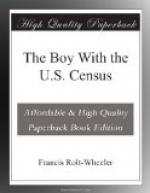“That works by the permutation of numbers,” was the reply. “You can arrange two numbers in only two ways, but you can arrange three figures in six ways, four in twenty-four ways, five in one hundred and twenty ways, six in seven hundred and twenty, seven in over five thousand ways; ten would give you over three and a half million ways of changing them around—and you can see for yourself where forty-eight would land you. The actual address, street, and house number, and everything else we get by reference to the schedule.”
“That’s enough!” cried Hamilton. “I can see now. It would take a sheet of paper a city block long merely to write down the figures.”
“If you wrote down end to end all the possible relations that forty-eight figures could be put into you’d need a lifetime to write them down. Why, just with an alphabet of twenty-four letters, Leibnitz the great mathematician, calculated that over six hundred septillions of easily pronounceable words, none over three syllables long, could be arranged. We have room enough to arrange any trifling little matter like seventy or eighty million addresses, although, in truth, the gang-punch merely provides the district and section of district, and the schedule would give the rest if we had any need to refer to it.”
“I see,” said Hamilton, “and I suppose a number is put on the card which corresponds with every district number on the schedule. Then I come in on all the rest of the card.”
“Yes, every other hole is punched by the clerk.”
“But this machine doesn’t seem to punch,” the boy objected; “I put in a canceled card just now and tried it, but when I put the key down, nothing happened, the key just stayed down.”
“It’s not supposed to punch until the whole card is ready,” the other explained. “You depress into position the various keys you want until all the records needed for this one card are ready. Then you can glance over your keyboard, comparing what might be called your map of depressed keys with the line of the schedule you are copying. If one is wrong, you can release that one and put down the correct one in its place, the card being as yet untouched. You see, each field or division of the card corresponds with a differently colored section of the keyboard, and this makes it easy to insure accuracy in reading from the schedule.”
“But how is the punching done, then?” queried Hamilton.
“You press the bar,” the foreman explained, “and that throws in the motor attached to the punching mechanism, which brings the entire die and card up against the end of the punches which have been depressed by the operator, including, of course, the gang-punch, and these perforate the card. It is then immediately withdrawn, and drops automatically into either the ‘male’ or the ‘female’ compartments of the machine, the location of the hole tilting the slide that determines on which side the punched card shall fall.”




